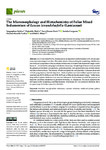The micromorphology and histochemistry of foliar mixed indumentum of leucas lavandulaefolia (Lamiaceae)
| dc.contributor.author | Naidoo, Y | |
| dc.contributor.author | Dladla, T | |
| dc.contributor.author | Dewir, YH | |
| dc.contributor.author | Gangaram, S | |
| dc.contributor.author | Naidoo, CM | |
| dc.contributor.author | Rihan, Hail | |
| dc.date.accessioned | 2021-10-14T11:29:17Z | |
| dc.date.available | 2021-10-14T11:29:17Z | |
| dc.date.issued | 2021-08-25 | |
| dc.identifier.issn | 2223-7747 | |
| dc.identifier.issn | 2223-7747 | |
| dc.identifier.other | ARTN 1767 | |
| dc.identifier.uri | http://hdl.handle.net/10026.1/18059 | |
| dc.description.abstract |
Leucas lavandulaefolia Sm. (Lamiaceae) is an important medicinal plant with a broad spec-trum of pharmacological activities. This study aimed at characterizing the morphology, distribution, and chemical composition of the secretions of trichomes at different developmental stages on the leaves of L. lavandulaefolia, using light and electron microscopy. Morphological observations revealed the presence of bicellular non-glandular, glandular peltate, and capitate trichomes on both adaxial and abaxial leaf surfaces. The density of both non-glandular and glandular trichomes decreased with the progression of leaf development. Heads of peltate and short-stalked capitate trichomes were between 20.78–42.80 µm and 14.98–18.93 µm at different developmental stages. Furthermore, long-stalked capitate trichomes were rare and infrequent. Leaf sections revealed the presence of important secondary metabolites in glandular trichomes, i.e., terpenoids. This study represents the first report on the morphology and histochemistry of trichomes of L. lavandulaefolia; therefore, there is a great scope for further research in this field. | |
| dc.format.extent | 1767-1767 | |
| dc.format.medium | Electronic | |
| dc.language | en | |
| dc.language.iso | en | |
| dc.publisher | MDPI | |
| dc.subject | bicellular non-glandular trichomes | |
| dc.subject | capitate trichomes | |
| dc.subject | medicinal plants | |
| dc.subject | peltate trichomes | |
| dc.subject | secretion mode | |
| dc.title | The micromorphology and histochemistry of foliar mixed indumentum of leucas lavandulaefolia (Lamiaceae) | |
| dc.type | journal-article | |
| dc.type | Journal Article | |
| plymouth.author-url | https://www.webofscience.com/api/gateway?GWVersion=2&SrcApp=PARTNER_APP&SrcAuth=LinksAMR&KeyUT=WOS:000701071000001&DestLinkType=FullRecord&DestApp=ALL_WOS&UsrCustomerID=11bb513d99f797142bcfeffcc58ea008 | |
| plymouth.issue | 9 | |
| plymouth.volume | 10 | |
| plymouth.publication-status | Published online | |
| plymouth.journal | Plants | |
| dc.identifier.doi | 10.3390/plants10091767 | |
| plymouth.organisational-group | /Plymouth | |
| plymouth.organisational-group | /Plymouth/Faculty of Science and Engineering | |
| plymouth.organisational-group | /Plymouth/Users by role | |
| plymouth.organisational-group | /Plymouth/Users by role/Academics | |
| dc.publisher.place | Switzerland | |
| dcterms.dateAccepted | 2021-08-18 | |
| dc.rights.embargodate | 2021-10-15 | |
| dc.identifier.eissn | 2223-7747 | |
| dc.rights.embargoperiod | Not known | |
| rioxxterms.versionofrecord | 10.3390/plants10091767 | |
| rioxxterms.licenseref.uri | http://www.rioxx.net/licenses/all-rights-reserved | |
| rioxxterms.licenseref.startdate | 2021-08-25 | |
| rioxxterms.type | Journal Article/Review |


